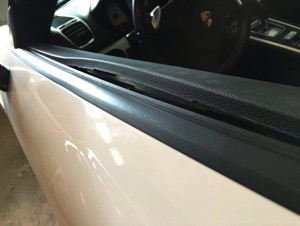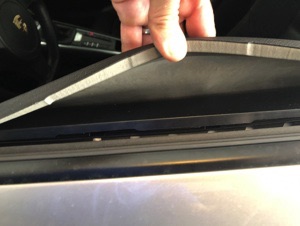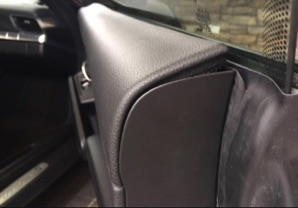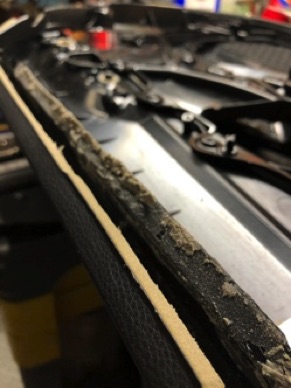Published in the December 2020 issue of “Porsche Profile”
Ⓒ2020 Technolab / PedrosGarage.com

Happy Porsche'ing,

First of all, Full Disclosure.
I have a shop that specializes in the restoration of warped and delaminated Porsche panels.
But that’s not the point. I want to share with you many of the things that I’ve learned about this issue so, if/when you have it, it’ll save you time and money, especially the latter.
What is it?
People refer to it as warped door panels and/or delaminating door panels, and that’s a fair description of the problem.


Which cars are susceptible?
All Carrera models manufactured after 2012 (991 and 992), all Boxster and Cayman models manufactured after 2013 (981 and 718). To a lesser extent, we have also seen some Cayenne and Macans suffer the same fate.
Why does it happen and why is it so common?
Don’t blame Porsche, this one wasn’t their fault!
At the turn of this century German worker safety regulations (TRGS 610) required that solvent-based adhesives for floor coverings (carpets mostly) had to be changed to water-based dispersions to improve indoor air quality by the reduction of Volatile Organic Compounds (VOC).
Then in 2010 it was mandated that German auto makers could no longer use solvent-based adhesives anywhere in the cabin of their vehicles and the new regulation had them switch immediately (2011) to water-based ones.
But the door panels for the new upcoming models (991/992 and 981/718) were already being produced and the materials and fabrication procedures required the very specialized adhesives they were using. Nevertheless they had to switch. Needless to say, the water-based adhesive is not the right one for those panels.
Exactly, what happens?
With age (6+ years), ambient heat and humidity, the water-based adhesives deteriorate and the “skin” of the door panel starts to separate (delaminate) from the door panel’s plastic frame. It generally becomes obvious at the top rear portion of the panel (where the end-cap is located). This portion, which must allow the airbag to deploy in case of a side impact, is perforated from the factory so it can tear if the airbag inflates.

But as the “skin” becomes detached, it looses structural integrity and starts to tear with the expansion and contraction of daily temperature swings. Once this happens the rest of the panel quickly starts to come off its base and bows upwards (warping) along the top edge. With the skin off the base, the plastic base can and will warp (deform) with just the heat of the sun on a clear day.
Very unsightly on such beautiful cars.
At this time the owner generally calls the dealer to inquire whether this is an issue covered under warranty. After 4 years the answer is “no, it is not”.
How much to repair them?
The answer from the dealership is not what any owner wants to hear: “We do not repair them, we only replace them and the cost per panel varies between $1,400 and $2,400” give or take a few bucks (plus labor). To make matters worse, the panels are replaced with OEM ones that will suffer the exact same fate in another half dozen years or so.
So the owner starts to think, heck with just a little glue, I’d better make that a strong glue or maybe even epoxy, I can fix that and save all that money.
My recommendation:
After having dealt with the aftermath of hundreds of botched DIY jobs, please don’t do it. Don’t do it because the foam that backs the leather or leatherette is very sensitive to most adhesives and can deteriorate to the point where it can’t be restored.



Also when DIY’ers see the detached perforated plastic, the logical reaction is to lather on a layer or two of the strongest epoxy they can find so it’ll hold. Well, that’s not good either, because the reason it’s perforated is so that it can allow the Airbag to save a life. If it’s epoxied in place there will be issues with the airbag in case it has to deploy.
For us to repair a straight up delamination, it’s fairly straightforward, but before we can start to work on a panel that’s been “repaired” previously, we need to remove all of the adhesive that was used and restore any missing foam material, which adds time and cost to the restoration.
It’s best, as in most things, to catch it early. The repair is less costly and quicker.
How is it repaired?
We developed our own procedures and tested multiple adhesives throughout many years and hundreds of panels.
We found out that the temperature inside a dark colored door, parked for just 90 minutes in full sun, can reach upwards of 220 ºF, which makes most adhesives gooey and useless, so a specialized high-temp adhesive was sourced. But the adhesive should not damage the delicate inner foam and that was another hurdle. Also, the plastic material used on the panel’s base de-gasses in a way that negatively affects adhesion, so a primer and an adhesion promoter was also sourced.
The perforated part that tears also needs to be addressed. It has to be secured in a way that holds it in place permanently with the exception of a possible Airbag deployment when it needs to let the panel fold downwards so the Airbag can do its job.
Finally, the warping of the panel’s substrate needs to be corrected to a very specific shape to fit the slightly curved contour of the door. This is done by warming up the panel and placing it in a custom jig overnight. This final process does two things; it cures the high-temp adhesives and it restores the original shape of the panel so it fits and looks like new again.
By the way, we don’t use water-based adhesives so our repairs are permanent.
So go, check you door panels and catch them when the delamination is just starting.
By the way, when one of them starts to delaminate, the other side has probably also started as well.
To learn more about door panel delamination / warping repair, please visit my website at: www.PedrosGarage.com.

